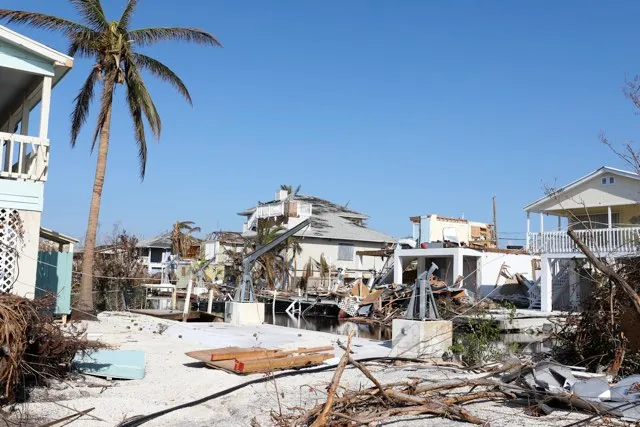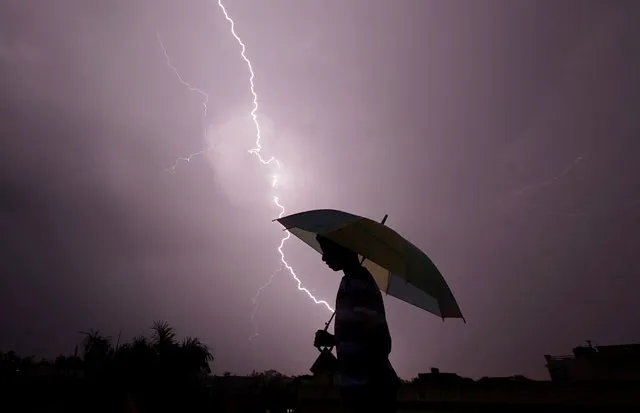The Earth's rotation creates most of our weather; the temperature alternation between night and day for starters, as well as the complex system of winds and currents that deliver stormy or sunny weather to every corner of the Earth. Not only that, but storms and fair weather systems (lows and highs) themselves are set to spinning in opposite directions by a peculiar consequence of the Earth's rotation, the Coriolis Effect.
In the northern hemisphere anything airborne and moving in a straight path in any direction — east, west, north or south — has a tendency to deflect to the right, while in the southern hemisphere it has the opposite inclination. This tendency is named after the French engineering professor, Gustave-Gaspard de Coriolis, who discovered it in 1835. It is so pervasive that even long-range artillery guns have to be specially calibrated to compensate; otherwise, they would miss their targets.
So why the difference between the northern and southern hemispheres? In both hemispheres the Sun rises in the east and sets in the west, but that's about it for similarities because the northern hemisphere and the southern hemisphere rotate in opposite directions. But how can this be? How can two halves of a single planet spin in opposite directions? It's one of the profound paradoxes of rotating spheres but it can be solved with simple thought experiment.
Imagine you are on a spacecraft approaching Earth from above the southern pole. You would descend on a planet spinning clockwise. But take the same spacecraft and approach the Earth from the North Pole, and you land on a planet spinning counterclockwise. Voila.
Listen to episodes of the Science Focus Podcast about the weather:
- How accurately can we predict the weather? – Andrew Blum
- What's going on with the weather? – Dann Mitchell
In order to correct this counter-intuitive asymmetry of Earth I've come up with a planetary engineering proposal. Why not make both halves of the Earth spin in the same direction?
To begin, the northern hemisphere and the southern hemisphere would have to be separated along the equator with a deep slice, like the groove in a yo-yo, that extended all the way to the centre of the Earth. Then two immense discs of stainless steel, the same diameter as Earth at the equator, would be positioned to cap these halves. (Of course the outer edges of the discs would have to be shaped to follow terrain. Sometimes mountains would be split right down the middle, but oceans would be easier, the edge of the two discs would only have to rise to sea level, like an infinity pool.) An industrial-grade lubricant would grease the contact zone between the two hemispheres.
To complete my imaginary project, the mega-engineers would have to choose one hemisphere, let's say the southern, and gradually slow it down using retro-thrust from giant rocket engines set along the equator. When it stopped they'd set it spinning in the opposite direction with another set of rocket engines.
The southern hemisphere, from the perspective of the South Pole, would now be spinning counterclockwise, in the identical direction as the northern hemisphere. Low-pressure cells in the southern hemisphere would likewise now rotate counterclockwise while high-pressure cells would rotate clockwise. No more discrepancy between the northern and southern hemispheres! Paradox solved.

But there would be some consequences. At the equator the Earth's rotation speed is 1,037 miles per hour (1,670 kilometres an hour), so the two hemispheres would be sliding past each other at the combined speed of 2,074 miles per hour (3,340 kilometres an hour).
People living near the cleft would be rocked by constant sonic booms, as mountains and buildings on the other side of the equator screamed by at 2.7 times the speed of sound. Air travel would be the only means of getting from one hemisphere to the other because land or sea routes would be strictly impossible. Even then, I imagine, pilots would have to make the crossing at some altitude to avoid turbulence.
Gravity would still hold the two halves of our engineered planet together but air masses over the equator would be vertically sheared by the opposing velocities. Tornado-like vortices would constantly peel off the slip-zone and wreak havoc. I'd venture to say that the present arrangement is far superior, if enigmatic. So we have to live with the Coriolis effect. And it has a huge effect on weather. Hurricanes for example.
Hurricane Alley
As air over the equator is heated, it rises and travels northward in the upper atmosphere then sinks and travels southward in the lower atmosphere, forming a kind of tubular vortex that rings the Earth called a Hadley cell. The southward travelling winds of the Hadley cell are deflected to the right by the Coriolis effect producing winds blowing from the north-east to the south-west, ergo; the North East Trade Winds.
The North East Trade Winds dominate a world-girdling belt of ocean and land just north of the tropic of Cancer, and they shunt all the weather in their path — highs, lows, tropical depressions, you name it — westwards. They even blow red dust from the Sahara all the way to Florida.
That's why a typical hurricane, which often begins its life as a storm in Chad, Africa, marches steadily eastwards; through Nigeria, on through southern Mali and Guinea and then finally blowing out into the Atlantic Ocean just south of the Cape Verde Islands.
If Northern Africa is the nursery for fledgling hurricanes then the Cape Verde islands are their marshalling grounds. In the late summer months these islands oversee the birth of dozens of tropical waves (a term for a fledgling storm) that, in turn, often transform into tropical depressions which then, under the right conditions, turn into hurricanes.
These depressions are picked up by the North East Trade winds and propelled on a westward drift along an east-west strip of tropical Atlantic Ocean that stretches some 2,408 miles from the east African coast to the Caribbean. Hurricane Alley.
Reader questions about the weather:
- Why does hot weather make me turn into the Hulk (i.e. very, very angry)?
- Why do the British talk about the weather so much?
- Can weather affect the behaviour of a cricket ball?
In the summer the south Atlantic heats up like brine soup and as the trade winds usher seedling hurricanes westwards they grow larger, evolving from tropical waves into tropical depressions and then into tropical storms. Hurricane alley is like the metal conveyor belt that runs through the oven of an industrial bread factory, only the airy loaves that pass through this assembly-line bakery puff up on moist, thermal updrafts from a hot ocean.
Water temperatures must be a minimum of 26.5°C down to a depth of at least 50 metres to properly spawn a storm and during a hot summer Hurricane Alley can sustain and build a storm all the way from its fledgling stage off the coast of Africa to becoming a monster hurricane.
Thunderstorms
A hurricane is really a series of linked cumulonimbus thunderstorms spinning in a circle. To give you an idea of the size and power of a hurricane you simply have to compare the power output of a single thunderstorm, which discharges enough energy to supply the entire US with electricity for 20 minutes, to the average hurricane, which possesses the equivalent to 200 times the worldwide electrical generating capacity.
Tremendous power. Yet even that pales against the fact that our planet hosts approximately 44,000 thunderstorms daily. That means that the Earth is being struck by lightning 100 times every second.

Temperatures at the core of a lightning bolt can be as high as 29,982°C, or six times hotter than the Sun's surface, instantly vaporizing the narrow tunnel of air it cauterises. The surrounding air is compressed outwards by the lightning's passage — bang — and the shockwave travels at the speed of sound until it reaches our ears as thunder.
Radio Thunder
If you take an AM radio and tune it between stations you will hear static — little bursts of crackling noises, some faint, some louder. This is the sound of lightning from distant storms arriving the form of the radio-frequency pulses. These radio signatures are called sferics and the faintest are thousands of miles away.
But if you have a tuner that can receive VLF (very low frequency) radio signals, and tune it between stations (there's not a lot of them) you will likely hear very strange noises, descending whistles like the sound of bombs falling. These are sferics that have leaked out of the lower thermosphere and travelled along the magnetic field lines at the edge of the exosphere, the outermost layer of the Earth's atmosphere, some 6,000 miles above Earth's surface and back again.
On their trip through the magnetized plasma in the exosphere the sferics get dispersed, stretched out, and arrive back at Earth in a series of descending tones instead of a single static crackle. Sometimes the same whistler will bounce back and forth, caught in the magnetosphere, the descending tones get getting longer and fainter until it dissipates entirely. Music of the spheres indeed.
18 Miles:The Epic Drama of the Atmosphere and its Weather by Christopher Dewdney is available now (£16.99, Bloomsbury Sigma)
Follow Science Focus onTwitter,Facebook, Instagramand Flipboard